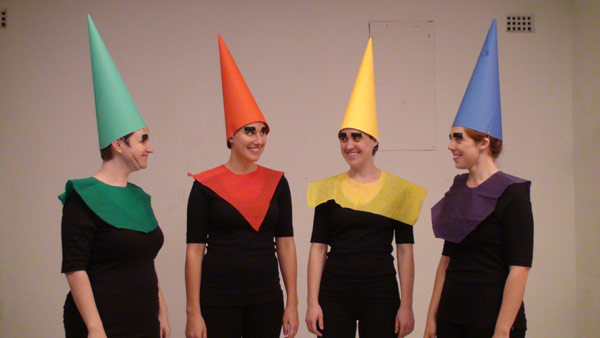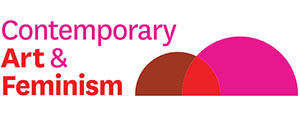Catriona Moore
Published courtesy of Eyeline #80, 2014, pp.106-107

Brown Council: One Hour Laugh, 2009
When considering the stereotyped oxymoron ‘Feminism and Humour’ before approaching this show, I was initially stumped. After despondently trawling Google for ‘feminist jokes’ (‘Q: What do you call a blonde flying a plane? A: A pilot, you asshole’), I was not certain whether to approach Backflip: Feminism and Humour in Contemporary Art with an eye out for more highbrow dry wit, droll wordplay, or elegant, parodic gestures. Thinking back over decades of feminist humour, however, what I mainly remember is smut: really funny, dirty visual jokes. A lost world of dripping-red tampon earrings, aroma-rama installations, agit-prop doyleys and cleansing performances that spooked the art world subconscious through the 1970s, then quietly gathered dust behind the curatorial curtain.
Until now.
Curator Laura Castagnini curates a contemporary, light-hearted, even silly character of contemporary work, within a lineage of funny feminist art practices. Backflip peppers a cheerful raft of crackup installations and videos from the last few years with a few oldie-but-goodies—Louise Lawler’s Birdcalls (1972–81) provides a cheerful entry-point, chirping the names of canonical (male) artists of her generation as you pass through the gallery entrance.
Backflip has all the wow! factor of current feminist curating that is enlivening the contemporary art world with colour and movement—think Contemporary Australia: Women (GoMA, 2012), Sexes (Performance Space, Carriageworks, 2012) or Scream (Artspace, 2013). Then again, feminist art has always sullied the white cube with domestic clutter, feral performance and unconventional subjects. Backflip is no exception, and the result is stimulating if somewhat exhausting. As with many feminist shows, complex themes make for lateral thinking with materials, surprise herstorical inclusions and domestically cluttered curatorial space. Comfortable beanbags are thoughtfully deployed around the show, and come in handy when watching the substantial film program in the adjacent video lounge. Some of the strongest contemporary works are in fact hilariously performed documentaries or document hilarious performances (from Tracey Moffatt’s original Bondi Beach babe-watch Heaven (1997), to Anna Leaton’s Piss Wife, in which a clean-cut country lass carefully sets a homey table with Country Women’s Association style cakes, then hops up, hitches up her frumpy dress and urinates on the afternoon tea.) Hannah Raisin’s the-title-says-it-all My Cunt Smoking Without Me (2007) and Sarah Lynch’s cringe-worthy, LOL ‘flashing at the docks’ performance, are similarly gross-out gems that suggest an entirely new take on the dirty joke, which Freud had noted back in 1906 enabled men of the educated classes to take pleasure in simple smut, usually at someone else’s expense.1
Castagnini first thought to re-gender the joke when interning at the Elizabeth A. Sackler Centre for Feminist Art at the Brooklyn Museum, which plays hostess to Judy Chicago’s monumentally (though unwittingly) funny The Dinner Party (1974-79). Some works in Backflip reference this old shaggy-dog—Frances (Budden) Phoenix’s cheekily lace-embroidered doyley was furtively stitched when the artist was part of a small contingent of Australians travelling to the States to join the Dinner Party workshop. Angered at Chicago’s authoritarian style and increasingly jaundiced by the uncritical nature of US radical-feminist ‘goddess worship’, Budden embroidered the blood-red words ‘No Goddesses/No Mistresses’ around an anarcho-feminist symbol, and was caught out attempting to sew this witty protest into a richly-embroidered table runner. Another mischievous antipodean intervention is the Hotham Street Ladies’ ‘You Beaut!’ uterine bas-relief in the men’s toilet. It serves as a clever, if unwitting, homage to Chicago’s Menstruation Bathroom, a tampon-encrusted, site-specific Environment, part of the pioneering 1972 ‘Womanhouse’ project in Los Angeles. Our Home-girl version is more cheerfully blood and guts, however, and corporeal shame is no longer on the vaginal agenda. The Ladies’ dripping-uterus-pools of scarlet cochineal (or maybe strawberry sauce, I didn’t squat to taste) lie over the grimy lino floor, and the toilet-bowl is ringed with happily winking, cherry-topped meringues. This cunt-cornucopia of glace cherries, icing sugar, jaffas, gob-stoppers, and 100s and 1,000s in the enclosed toilet cubicle, generates a sweet-smelling site-specificity that would not have been tolerated back in the early 1970s.
Castagnini’s strategy is thus strategically trans-generational. She notes in Backflip’s catalogue that ‘Laughter… has long been used as a strategy of political disruption and therefore lends itself quite readily to feminism’. For sure; yet I recall that, while laughter was a sharp, political tool in the streets and bars, back in those days the male-dominated art world had an undeveloped wit. Backflip thus indirectly asks why it has taken us so long to appreciate arty jokes that late modern audiences simply found traumatic? Were all those nappy-and-tampon installations, blood-smeared performances and goofy family albums so shamefully anti-aesthetic? Of course they were. When trying to trace a straight path across four decades of arty feminist humour, the point is that you just cannot. So much funny feminist work was just institutionally embarrassing. It was never pretty enough, and never witty enough.
It was not a simple problem of too much smut. Australian pop art always ventured below the bikini line… but audiences (and particularly critics) raised on the wholesome suburban diet of Brett Whiteley bums, Mike Brown busts and Richard Larter beavers found feminist body imagery just too rich, as Vivienne Binns discovered back in 1967 when her funky-sex dioramas (Vag Dens 1967, Suggon 1966) were ruled out of court by the critics (‘Have a double brandy, grit your teeth and see it’ wrote Rodney Milgate. Getting all that ‘sickness and sex’ off her chest (John Henshaw) was all well and good, but please, not in the gallery. We just hope all that embarrassing self-exposure will leave Miss Binns wholly well adjusted, opined Wallace Thornton.) Binns’s bad girl installation was more than just trash. It was abject waste, as suggested by the critics’ aversion towards ‘devious movement’, ‘flood’, ‘messy’, ‘morass’ and an ‘avalanche’ of ‘tormented, damaged forms’.2 The unbounded wetness of the show was a particular problem for the aesthetic terms that were then available. Feminist artists like Binns, Angela Gee, Toni Robertson, Mary Callaghan and others, were inventing a whacky and wondrous Rabelaisian imagery for which the art world was not ready.
Even in the ironic 1980s critics found feminist bodily-functions-and-waste-management unfunny. The Lovely Motherhood Show (Experimental Art Foundation, Adelaide, 1981) was slammed for its ‘icons of distress’ (Jenny Boult), and, following art world complaints, Sandy Taylor’s hyper-realist soft-form sculpture, lurking in a corner plastic bucket, had to be removed by the end of the first week. No postmodernist irony there, just bad mothers making bad art. The art world could not recognise the sheer pleasures to be obtained from the mediation and release of feminine psychosocial energy. Laughing at dangerous feelings of female desire, aggression and sexuality was a good way to face the weirder spaces and stuff of women’s lives.
In hindsight, however, old feminist dirty laundry looks no kookier than Robert Rooney’s line-up of neatly folded underpants (Garments 3 December 1972 -19 March 1973) or Domenico de Clario’s ‘clean up Australia’-style performances (Mildura Sculpturescape, 1973). Unfortunately, back then cunt, tampon and nappy motifs were misread as straight sexual aggression, whereas male intimates or domestic routines were lauded for either site-specificity or as witty conceptual skirmishes between art and life. Piero Manzoni’s sixties shit and Hany Armanious’s postmodern soiled Y-fronts were like Kleinian play therapy for jaded art lovers. The problem was that feminists had not managed to get their shit accepted as art in the first place. It was not until the 1990s ‘return to grungy arte povera’ that art audiences started to enjoy feminist installations of impossible desire and hostility, in equal measure (work by Mikala Dwyer, Destiny Deacon, Kathy Temin, Raquel Ormella, Justene Williams come to mind here). Feminist humour, formulated in harsh times, had sufficiently stretched aesthetic discourse to finally countenance the ‘return of the repressed’.
The younger generation of artists shown here in Backflip still unsettle museum orthodoxies through employing performative styles lifted from elsewhere—radical drag, burlesque, stand-up comedy, crafty-wafty hipster magazines like Frankie. In a recent Guardian review of Janis II (July 2013 at The Commercial and McLemoi galleries in Sydney, curated by Kelly Doley and Amanda Rowell), Andrew Frost noted how much contemporary art is washed through a nostalgia rinse. He adds that this trans-generational exchange makes sense with feminist projects such as Janis, as current art world inequalities ‘mean that a return to basics is required every decade or so. While nostalgia is often defined as a kind of cultural malady, it can also have a positive effect when it empowers a new generation to self-awareness and realisation’.3 I would add, however, that the difference between old and new jokes is not just in the telling. Told afresh, in changed contexts to changed audiences, old jokes change shape, exchange punch lines, go viral.
Catriona Moore
Notes
1. Anna Leaton’s Piss Wife, Hannah Raisin’s My Cunt Smoking Without Me (2007), and Sarah Lynch’s performance were not in the exhibition per se, rather they were included in the Victorian College of the Arts (VCA) Video Lounge, in an archive of funny feminist videos made by former students during their time at the VCA School of Art.
2. The critics’ response to Binns’s 1967 Watters Gallery show was reported in ‘Interview with Vivienne Binns’, the ‘Women and the Visual Arts’ issue of Scarlet Woman, Vol.8, April 1975, p.16.
3. Andrew Frost, ‘What can nostalgia bring to contemporary art?, http://www.theguardian.com/artanddesign/australia-culture-blog/2013/jul/31/nostalgia-contemporary-art-culture

